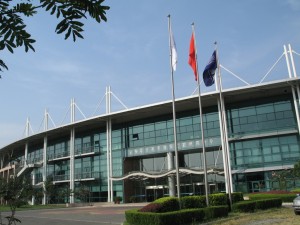Chinese biochips reflect growing biotech spending

 BEIJING -- China may be associated with low-tech manufacturing, but Beijing biotech firm CapitalBio offers something different. In the sunlit atrium of CapitalBio’s Beijing R&D center, CEO Jing Cheng stands proudly next to a display case containing products based on biochip technology. The products were designed and manufactured in China, and have generated nearly 150 patents for his firm.
BEIJING -- China may be associated with low-tech manufacturing, but Beijing biotech firm CapitalBio offers something different. In the sunlit atrium of CapitalBio’s Beijing R&D center, CEO Jing Cheng stands proudly next to a display case containing products based on biochip technology. The products were designed and manufactured in China, and have generated nearly 150 patents for his firm.
Biochips are about the same size as computer chips, but are covered with short strands of DNA, rather than electronic circuits. By testing how different proteins bind with the DNA on the chip, scientists can determine the genetic makeup of different proteins. The technology can be used to screen patient’s inherited genetic traits, including inherited allergies and disorders. “This device can be used to screen for 80 genetic disorders,” Cheng said, pointing at a tiny diagnosis kit. Another device, whose plastic moulding resembles a computer printer, contains a robotic arm for running tests on biochips. There are also non-biochip based devices, including a tiny kit for testing the heat tracking ability of human sperm. “Previous devices only checked sperm’s speed of movement,” he said.
China has been investing heavily in biotechnology for over a decade, and investment is set to increase over the next five years. China's government has named biotechnology as one of seven strategic industries which are set to receive 1.7 trillion USD in government funding over the next five years. TheUS has invested about a trillion dollars into the biotech sector since 2000, from public and private sources.

CapitalBio’s biggest market is still domestic. Beijing’s city government paid 100 million RMB (about 15 million USD) to purchase CapitalBio’s biochip diagnosis kits last year, which will be used to screen all of the city’s newborn babies for a potentially deafness-causing allergy to antibiotics. But the company is increasingly exporting its products to the US and Europe, signing a deal with Pharmaceutical company Roche to sell fifty Biochip washers to the US. The company has sold more than 200 biochip scanners to European clients. "Europe is now our second biggest market," Cheng said. Staff numbers have grown from twelve employees when the firm was founded ten years ago, to around 500 today.
Chinese Biotech firms are dependent on the government for the majority of their funding. CapitalBio also goes by the name of China's "National Biochip Engineering Research Center," a sign of government support for the company. About eighty percent of CapitalBio’s funding comes from the government indirectly through university research grants, Cheng said. The firm also received 50 million RMB (about 8 million USD) in direct funding as part of China’s “863 program”, which is focused on supporting hi-tech industry. Most private investment in Chinese biotech has come from foreign multinationals. “Chinese investors often see the industry as too risky,” Cheng said. “But their attitudes are becoming more positive.”
China’s bureaucratic healthcare system slows the entry of new biotech products into the domestic market, according to Cheng. Chinese hospitals can take as long as four years to update their purchasing inventories with new treatments, compared to around six months in the US. “We have to go to every province and persuade them to add our products,” he said. “It’s a massive waste of resources.” Sales are also limited by Chinese life insurance companies, who are less willing to pay out for new biotech treatments than their US counterparts, Cheng said.
China still faces a massive brain drain problem. Seventy percent of students who enroll in a foreign university course never return to China, according to a 2007 survey. “We have an urgent shortage of talent,” Cheng said. China’s government launched the “Thousand Talents Program” in 2008, which offers scientists grants worth one million RMB (about 150 thousand USD) to return home, and rising living standards in China have attracted researchers and academics back to China. But there is still a shortage of workers with commercial experience, according to Cheng. “Attracting academics is not the same as attracting people with industry experience,” he said.
China’s weak enforcement of intellectual property laws stifled biotech development, but the situation has improved in recent years, Cheng said. In 2007, CapitalBio successfully sued a company set up by ex-employees for patent infringement, winning 200 thousand RMB (about 30 thousand USD) in compensation. “That would have been a less likely ten years ago,” he said.
China overtook the US to become the world’s top patent issuer this year, but questions remain about the quality of patents.“The number of patents has improved, but [the Chinese government] forgot one important thing: that patents need to be commercializable” Cheng said. Around 20% of Chinese patents are commercialized, but CapitalBio has a better record, he said. More than half of the patents hung on a “patents wall" in the company’s lobby have been commercialized, and two thirds of the patents were issued outside China, he said.
China is still can’t rival the US and Europe, who will dominate the biotech industry for decades to come, Cheng said. “Even in thirty years we can’t expect to be the world leader in Biotech,” he said. “If China can develop a few world leading technologies, that would be good enough.”
Pictures: Tom Hancock, CapitalBio.
This post was originally published on Smartplanet.com